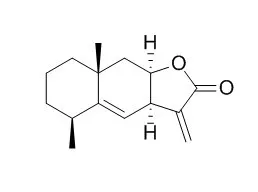| Kinase Assay: |
| J Ethnopharmacol. 2015 Apr 7. | | Mechanism-based inhibition of Alantolactone on human cytochrome P450 3A4 in vitro and activity of hepatic cytochrome P450 in mice.[Pubmed: 25858508] | Alantolactone (AL), one of the main active ingredients in Inula helenium L., has been included in various prescriptions of traditional Chinese medicine. The effects of Alantolactone on cytochrome P450 (CYP450) were still unclear. This study evaluated the inhibitory effect of Alantolactone on cytochrome P450s in vitro and in vivo.
METHODS AND RESULTS:
The inhibitory effects of Alantolactone on the CYPs activity were evaluated in human liver microsomes (HLMs) and recombinant cDNA-expressed enzymes incubation system, and then determined by LC-MS/MS based CYPs probe substrate assay. C57BL/6 mice were treated Alantolactone orally (0, 25, 50, 100mg/kg) for 15 days. The inhibitory effects of Alantolactone on major Cyps in mice were examined at both the mRNA and enzyme activity levels. Alantolactone showed a potent inhibitory effect on CYP3A4 activity with IC50 values of 3.599 (HLMs) and 3.90 (recombinant CYP3A4) μM, respectively. Alantolactone strongly decreased CYP3A4 activity in a dose-dependent but not time-dependent way in HLMs. Results from typical Lineweaver-Burk plots showed that Alantolactone could inhibit CYP3A4 activity noncompetitively, with a Ki value of 1.09μM in HLMs. Moreover, activity of CYP2C19 could also be inhibited by Alantolactone with IC50 of 36.82μM. Other CYP450 isoforms were not markedly affected by Alantolactone. The inhibition was also validated by in vivo study of mice. Alantolactone significantly decreased mRNA expression of Cyp2c and 3a family.
CONCLUSIONS:
The study indicates that herb-drug interaction should be paid more attention between Alantolactone and drugs metabolized by CYP3A4. |
|
| Cell Research: |
| Phytother Res. 2015 Apr 17. | | Alantolactone from Saussurea lappa Exerts Antiinflammatory Effects by Inhibiting Chemokine Production and STAT1 Phosphorylation in TNF-α and IFN-γ-induced in HaCaT cells.[Pubmed: 25881570] | Skin inflammation is the most common condition seen in dermatology practice and can be caused by various allergic reactions and certain toxins or chemicals.
In the present study, we investigated the antiinflammatory effects of Saussurea lappa, a medicinal herb, and its marker compounds Alantolactone, caryophyllene, costic acid, costunolide, and dehydrocostuslactone in the HaCaT human keratinocyte cell line.
METHODS AND RESULTS:
HaCaT cells were stimulated with tumor necrosis factor-alpha (TNF-α) and interferon-gamma (IFN-γ), and treated with S. lappa or each of five marker compounds. Chemokine production and expression were analyzed by enzyme-linked immunosorbent assay and reverse transcription-polymerase chain reaction, respectively. Phosphorylation of signal transducer and activator of transcription (STAT) 1 was determined by immunoblotting. Stimulation with TNF-α and IFN-γ significantly increased the production of the following chemokines: thymus-regulated and activation-regulated chemokine (TARC): regulated on activation, normal T-cell expressed and secreted (RANTES): macrophage-derived chemokine (MDC): and interleukin-8 (IL-8). By contrast, S. lappa and the five marker compounds significantly reduced the production of these chemokines by TNF-α and IFN-γ-treated cells. S. lappa and Alantolactone suppressed the TNF-α and IFN-γ-stimulated increase in the phosphorylation of STAT1.
CONCLUSIONS:
Our results demonstrate that Alantolactone from S. lappa suppresses TNF-α and IFN-γ-induced production of RANTES and IL-8 by blocking STAT1 phosphorylation in HaCaT cells. | | J Biochem Mol Toxicol. 2015 May;29(5):199-206. | | Alantolactone Induces Apoptosis and Cell Cycle Arrest on Lung Squamous Cancer SK-MES-1 Cells.[Pubmed: 25597476] | Alantolactone, a sesquiterpene lactone compound, has variety of pharmacological properties, including anti-inflammatory and antineoplastic effects.
METHODS AND RESULTS:
In our study, Alantolactone inhibited cancer cell proliferation. To explore the mechanisms underlying its antitumor action, we further examined apoptotic cells and cell cycle distribution using flow cytometry analysis. Alantolactone triggered apoptosis and induced cell cycle G1/G0 phase arrest. Furthermore, the expressions of caspases-8, -9, -3, PARP, and Bax were significantly upregulated, while antiapoptotic factor Bcl-2 expression was inhibited. In addition, the expressions of cyclin-dependent kinase 4 (CDK4), CDK6, cyclin D3, and cyclin D1 were downregulated by Alantolactone.
CONCLUSIONS:
Therefore, our findings indicated that Alantolactone has an antiproliferative role on lung squamous cancer cells, and it may be a promising chemotherapeutic agent for squamous lung cancer SK-MES-1 cells. |
|






 Cell. 2018 Jan 11;172(1-2):249-261.e12. doi: 10.1016/j.cell.2017.12.019.IF=36.216(2019)
Cell. 2018 Jan 11;172(1-2):249-261.e12. doi: 10.1016/j.cell.2017.12.019.IF=36.216(2019) Cell Metab. 2020 Mar 3;31(3):534-548.e5. doi: 10.1016/j.cmet.2020.01.002.IF=22.415(2019)
Cell Metab. 2020 Mar 3;31(3):534-548.e5. doi: 10.1016/j.cmet.2020.01.002.IF=22.415(2019) Mol Cell. 2017 Nov 16;68(4):673-685.e6. doi: 10.1016/j.molcel.2017.10.022.IF=14.548(2019)
Mol Cell. 2017 Nov 16;68(4):673-685.e6. doi: 10.1016/j.molcel.2017.10.022.IF=14.548(2019)